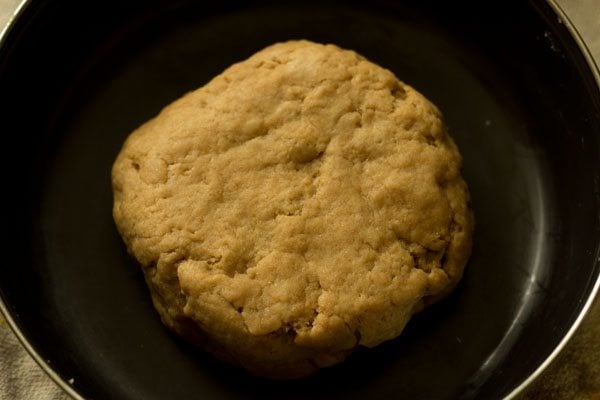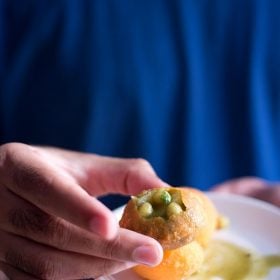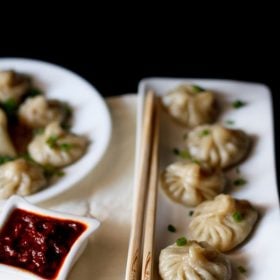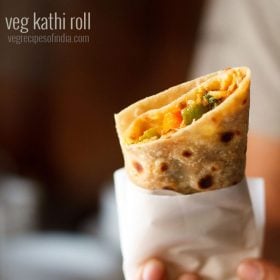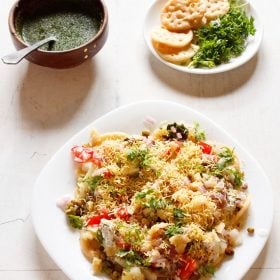
Crazy for samosas, but worried about the extra calories that come along with it being fried? Worry not, here’s my homestyle recipe of a Baked Samosa made with whole wheat flour that is not just healthy but is vegan too. Since this one is baked, you can indulge on this snack, a bit more and absolutely guilt-free. Check out my recipe to make it at home and serve all your loved ones.
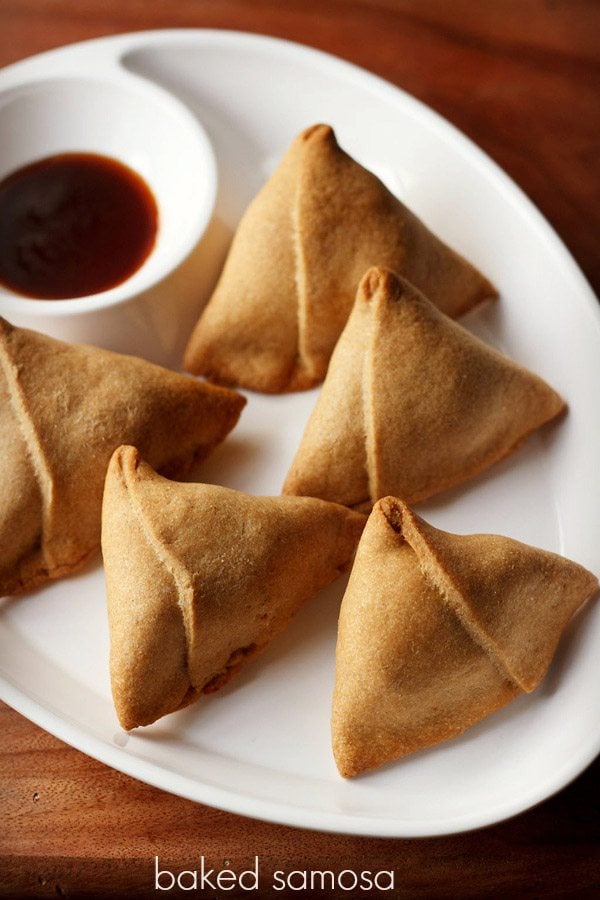

Why Bake Samosa
Sometimes we do want to have a non-fried and healthier version of popular fried Indian snacks like samosa. And why not? Healthy foods must be included in our diet.
Instead of deep frying, these snacks are baked making them a healthier option to munch on.
Thus this Baked Samosa recipe. I am eternally grateful to my cooking school days because it is where I learnt this particular recipe of Baked Samosa. It has always given me good results, and still continues to do so.
Most Indian snacks like Kachori, pakoda, chips, etc., when baked, do not taste like their fried counterparts. Of course, it goes without saying the fried ones are always tastier.
But at times you want something light for the heart as well as for the stomach, especially the ones that are the most loved Indian snacks. Hence, this Baked Samosa too.
Adding to this, for now, I only prepare samosas and Papdi in the oven. I tried baking pakoda too but did not like the texture of those made in the oven. The day I will ace a good recipe of a baked pakora done in the oven, I will definitely share the recipe here.
About Baked Samosa Recipe
Obviously, the texture of this Baked Samosa is not like the fried ones. These baked ones are crisp, flaky but you won’t get the texture that is achieved when they are fried.
As mentioned above, I have used whole wheat flour in the Baked Samosa pastry. Of course, you can use all-purpose flour (maida or refined flour or white flour) or half-half of both whole wheat flour and all-purpose flour.
You could bake these whole wheat samosas and if you want, you can even fry them. If you love the traditionally made Punjabi samosa, do check this detailed recipe of the deep fried Samosa.
It also has many tips on frying the samosa to get flaky and crispy texture. You can also check this Bengali version which is called as Singara.
Serve the vegan samosa hot or warm with tamarind chutney or mint chutney or even tomato ketchup.
How To Ace The Samosa Dough Crust For Baking
- Enough fat or ‘moyen’ should be added to the flour. One of my friends had suggested 1/5th of the fat to 1 part of flour in weight.
- The quantity of water that you will add will depend on the quality and texture of the flour used. So, remember to knead to a tight, firm dough and add water in turns while kneading.
- A pinch of baking soda does help in making the crust a bit soft.
- Avoid rolling the samosa crust too thick. Otherwise, it will take too much time to bake and it can become hard due to prolonged baking.
- Don’t roll the crust too thin, as it won’t able to contain the potato stuffing.
- Do brush the samosas with some oil before you bake them.
Step-by-Step Guide
How to make Baked Samosa
Prepare Pastry
1. Sieve 2 cups whole wheat flour and 1 teaspoon salt in a mixing bowl.
If there is too much of bran in the flour, then sift the flour thrice. You can add salt according to your taste.
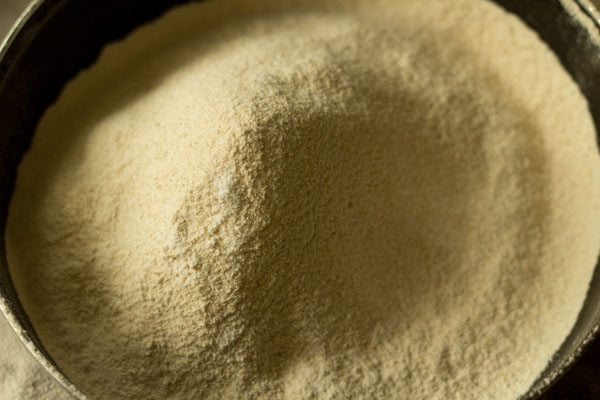

2. Add 5 tablespoons oil. You can also add ghee, if you want.
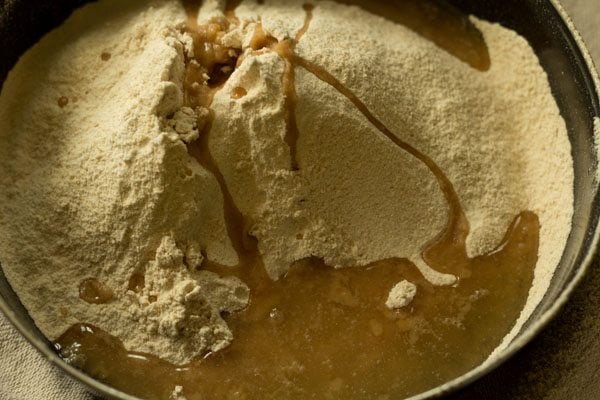

3. With your fingertips, rub the oil in the flour to get a sand like like texture and consistency.
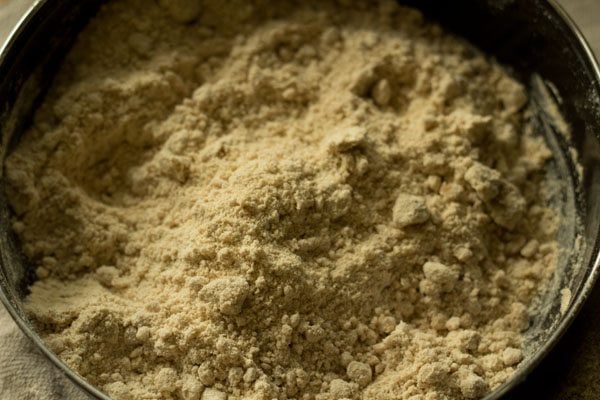

4. The entire mixture should clump together when joined. If not, then continue to rub the oil in the flour.
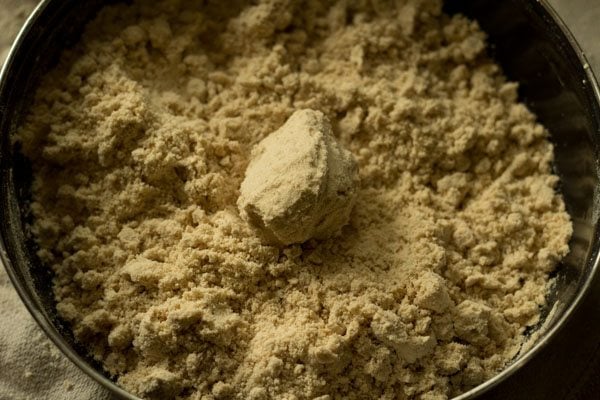

5. Next, add ⅓ cup water.
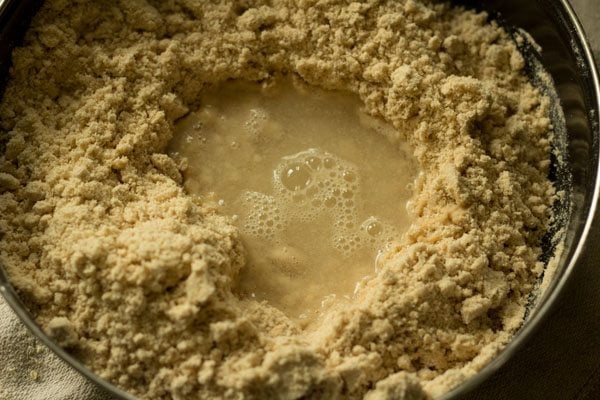

6. Begin to knead, adding more water, if needed.
Depending on the quality of flour, you may need to add less or more water. If using all purpose flour, simply add 4 to 5 tablespoons water first and then add more water, if required.
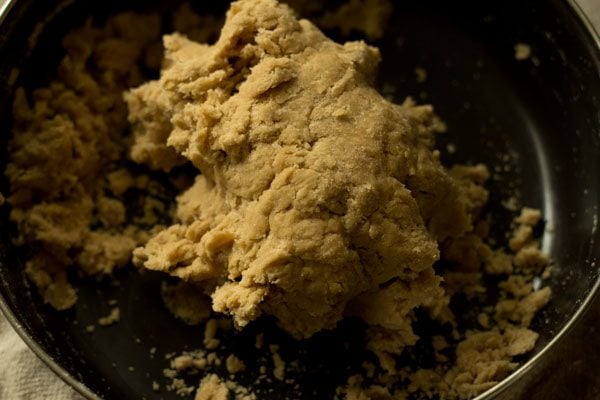

7. Knead to a firm and tight dough. Cover the dough with a damp napkin or kitchen towel and set aside to rest for 30 to 40 minutes.


Prepare Potato Stuffing
8. Steam or boil 250 grams potatoes (about 3 medium to large potatoes) until they are thoroughly cooked and tender.
You can cook the potatoes in a steamer pan, Instant Pot, stovetop pressure cooker or pot adding water as needed.
When the potatoes are warm or cool down, peel and chop them in small cubes.
Optionally if you like, add ⅓ cup green peas to the stuffing. Ensure to cook them with the potatoes.
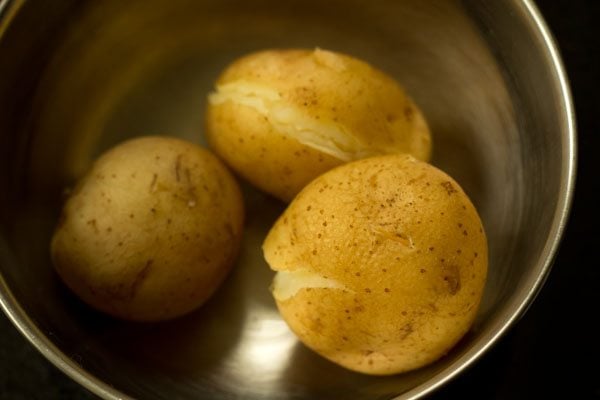

9. Crush 2 green chilies and 1 inch peeled ginger coarsely in a mortar-pestle.
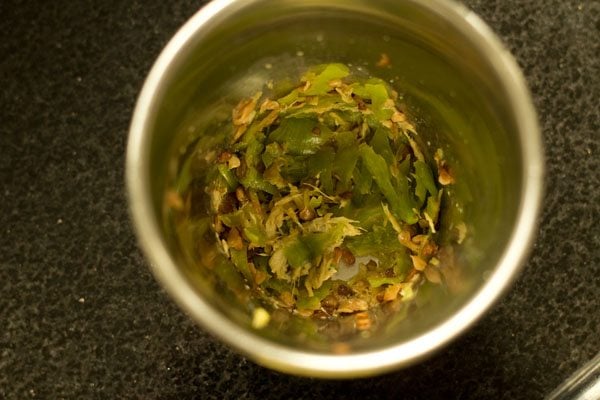

10. Heat 2 teaspoons oil in small frying pan. Add ½ teaspoon cumin seeds and sauté until they splutter.
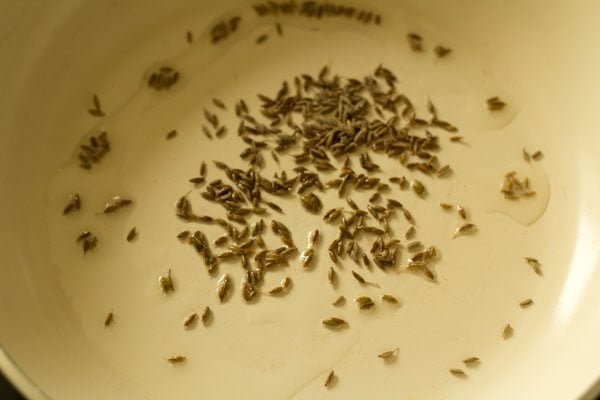

11. Add the crushed green chili and ginger paste. Mix well.
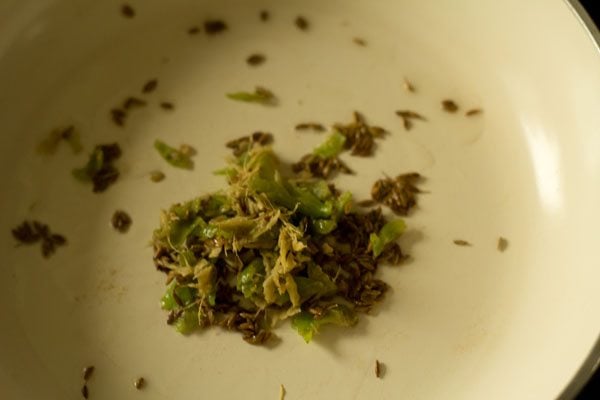

12. Next, add ½ teaspoon red chili powder and ½ teaspoon coriander powder. Mix again.
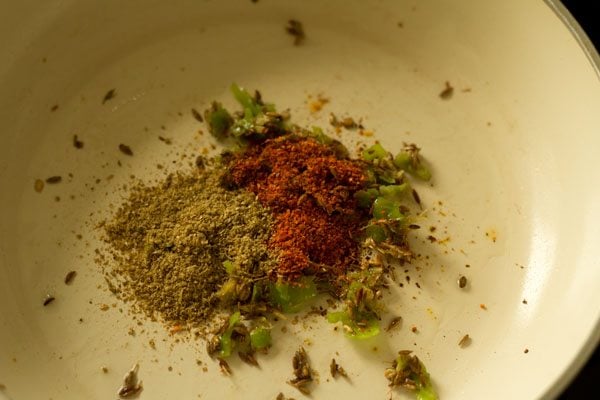

13. Add the potato cubes.
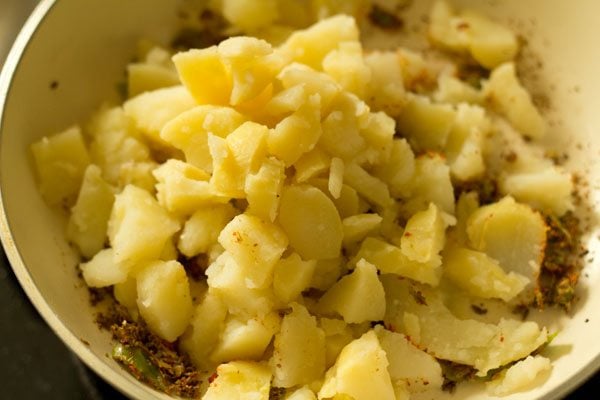

14. Mix the spices very well with the potatoes.
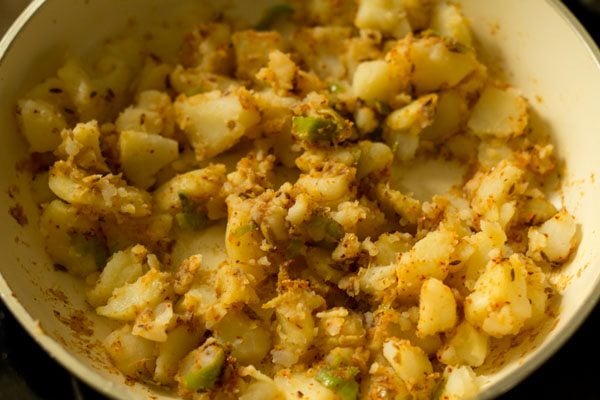

15. Now, add ¼ teaspoon garam masala powder, ½ teaspoon dried mango powder and salt as per taste.
If you do not have dried mango powder, then add a few drops of lime or lemon juice. You can also add dried pomegranate powder instead of dried mango powder.
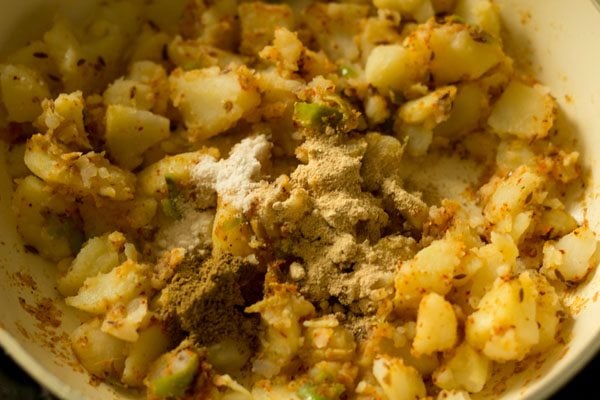

16. Mix everything again very well. Turn off the heat.
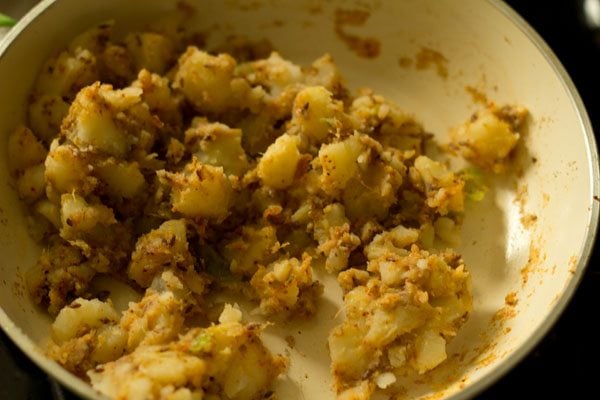

17. Lastly, add 2 tablespoons chopped coriander leaves, mix well and set aside.
Check the taste and add more red chili powder, garam masala powder and dried mango powder, if required.
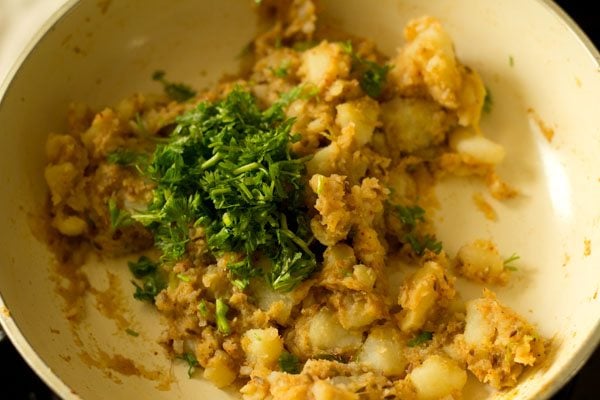

Assemble
18. After 30 minutes, knead the dough lightly again.
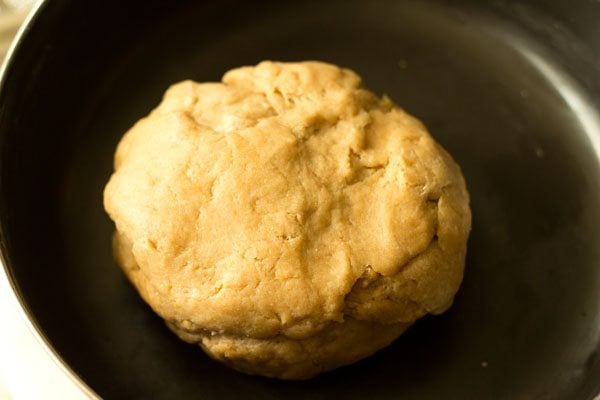

19. Make a log. Slice and divide the dough into 7 or 8 equal pieces.
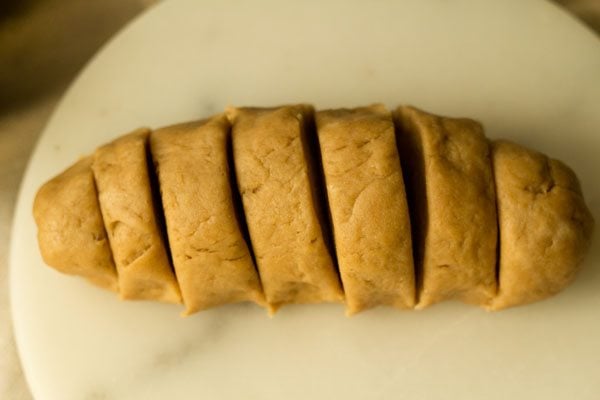

20. Take a dough piece. Roll it on your palms and place it on the rolling board.
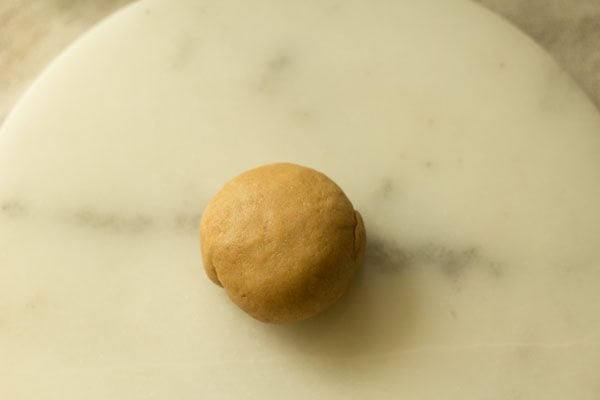

21. With a rolling pin, roll to a disc, keeping the thickness neither thin nor thick.
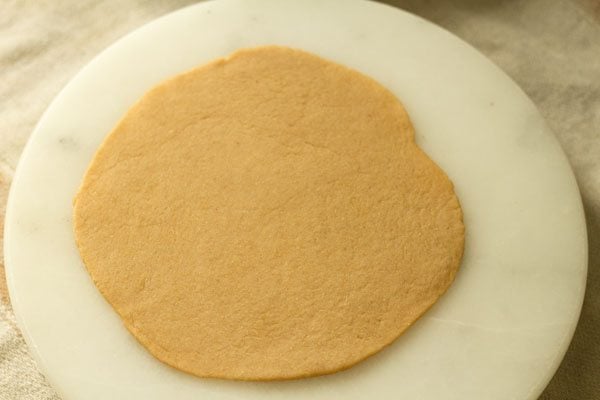

22. Cut with a knife or a pastry cutter through the center of the pastry disc.
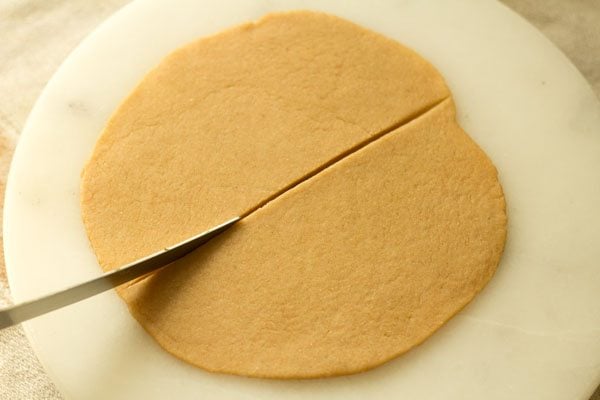

23. With a brush or with your finger tips, on the straight edge of the sliced dough, apply some water.
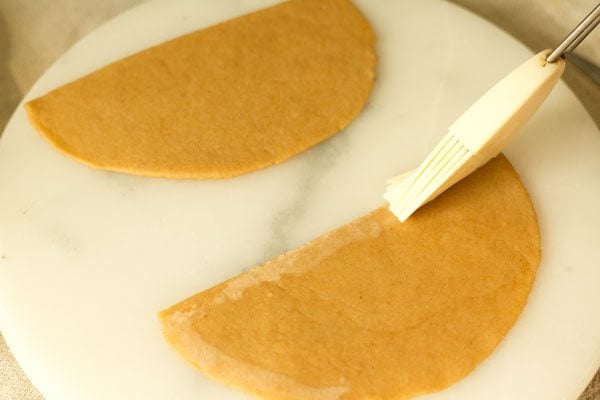

24. Bring together the straight edge with one of its end overlapping a bit the other end. Press and seal the edges.
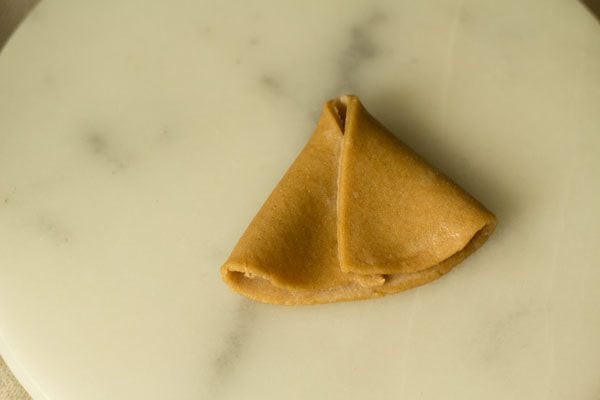

25. Press the edges well, so that they get sealed. It will look like a cone.
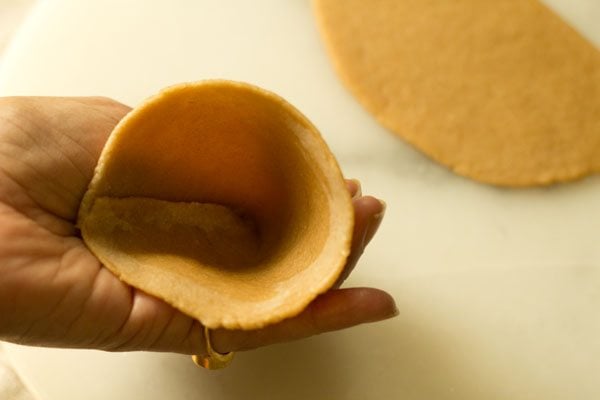

26. Now, with a small spoon, stuff the prepared potato mixture in the cone. Pinch a part in the edge as shown in picture below. This aids in keeping the samosa upright when placed on a tray.
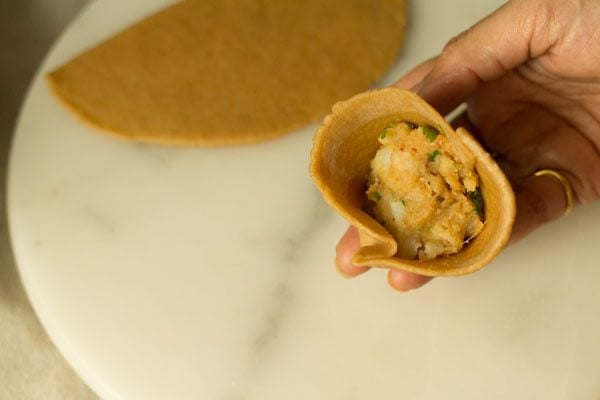

27. Press both the edges. Be sure there are no cracks. The edges should be joined very well.
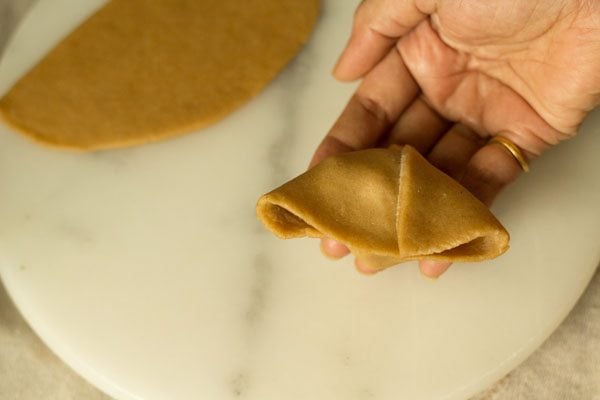

28. So, one piece is ready.
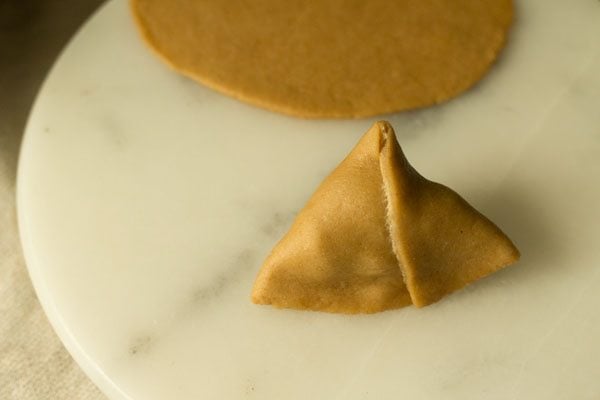

Bake Samosa
29. Assemble, stuff and shape all the samosa in this manner. As you go on making them, cover with a kitchen towel so that the outer pastry does not dry out.
Before baking, preheat oven at 180 degrees C/356 degrees F for at least 15 minutes.
Now, keep them in a baking tray. I baked 6 of them in the oven and 10 of them in the air fryer.
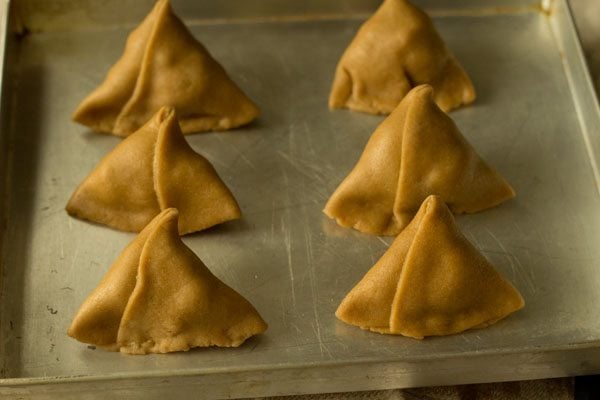

30. Brush them with some oil.
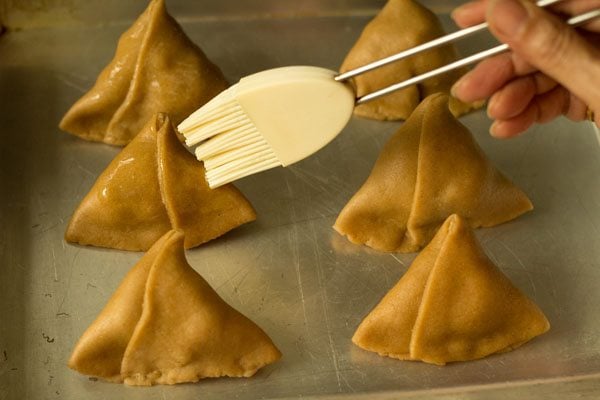

31. Bake in a preheated oven at 180 degrees C/356 degrees F for 30 to 35 minutes.
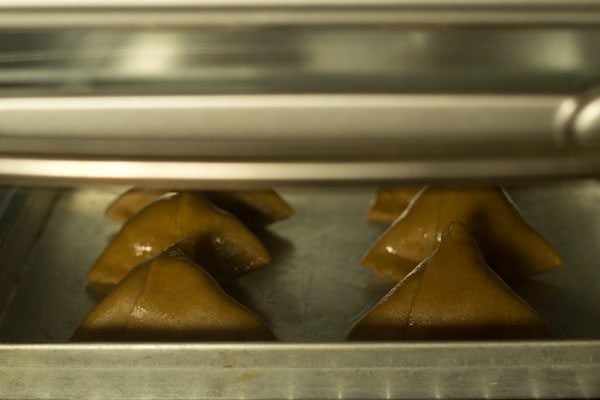

32. Bake until the crust is golden and crisp. I baked for 34 minutes.
Oven temperatures vary, so keep this point in mind. It can take less or more time for the baking to be complete in your time.
Be sure not to overdo the baking as this can make the crust too browned and hard.
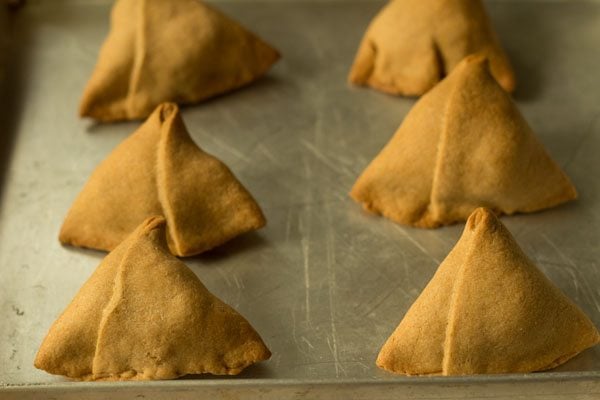

33. Allow them to cool down a bit for a couple of minutes as they will be very hot.
When they are hot enough to eat, then serve Baked Samosa with your favorite chutney or with tamarind chutney or coriander chutney or tomato ketchup.
You can also use these vegan samosas to make other tasty recipes like Samosa Pav or Samosa Chaat or Samosa Sandwich.
Refrigerate any leftover samosa in an air-tight container for 1 to 2 days. Before serving, warm the samosas in an oven.
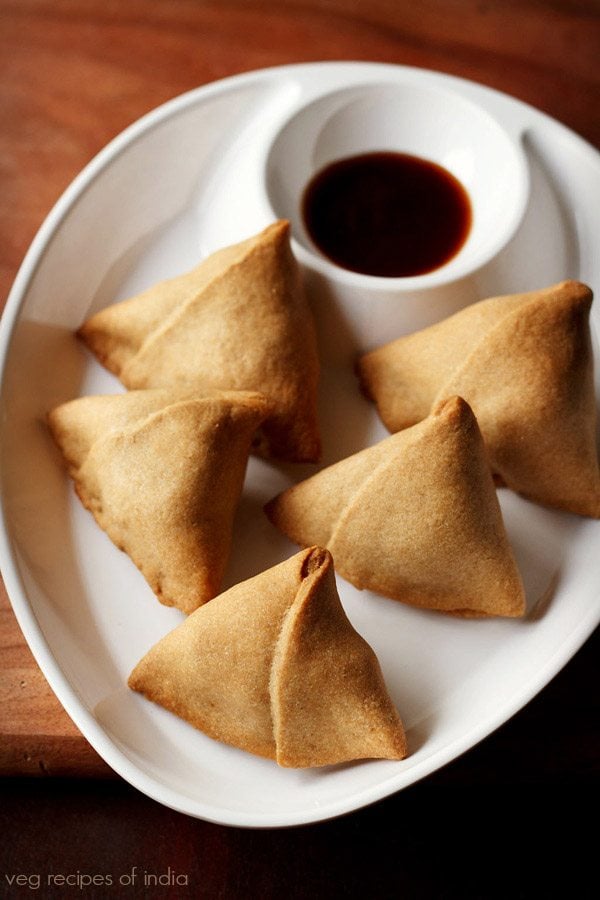

More Street Food Recipes To Try!
Street Food Recipes
Street Food Recipes
Street Food Recipes
North Indian Food
Please be sure to rate the recipe in the recipe card or leave a comment below if you have made it. For more vegetarian inspirations, Sign Up for my emails or follow me on Instagram, Youtube, Facebook, Pinterest or Twitter.
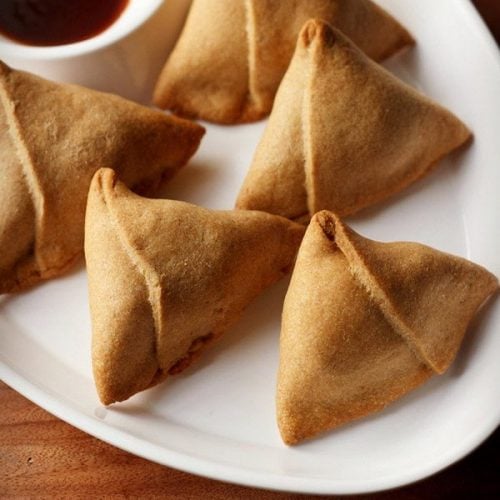

Baked Samosa (Whole Wheat & Vegan)
A homestyle recipe of a Baked Samosa made with whole wheat flour that is not just healthy but is vegan too. Since this one is baked, you can indulge on this snack, a bit more and absolutely guilt-free.
Prep Time 35 minutes
Cook Time 35 minutes
Total Time 1 hour 10 minutes
Prevent your screen from going dark while making the recipe
Making pastry
- Sieve the whole wheat flour and salt in a mixing bowl. If there is too much of bran in the flour, then sift the flour thrice. You can add salt as per your taste.
- Now add 5 tablespoons oil. You can also add ghee (clarified butter) if you prefer.
With your fingertips rub the oil in the flour to get a breadcrumb like consistency.
The whole mixture should clump and hold together when joined. If not then continue to rub the oil or ghee in the flour.
- Next add ⅓ cup water. Begin to knead adding more water if required. Depending on the quality of flour, you may need to add less or more water. Note that when using all purpose flour less water will be needed. For all purpose flour, simply add 4 to 5 tablespoons first and then add more water if required.
Knead to a firm and tight dough. Cover the dough with a moistened napkin or kitchen towel and keep aside for 30 to 40 mins.
Making potato stuffing
- Steam or boil the potatoes until they are fork tender and thoroughly cooked.When the potatoes become warm or cool, peel and chop them in small cubes. You can also add ⅓ cup steamed or boiled green peas to the filling.
Crush the green chillies and ginger coarsely in a mortar-pestle.
Heat 2 teaspoons oil in small frying pan. Add the cumin seeds and sauté till they splutter.
Next add the crushed green chili and ginger paste. Mix well on low heat.
Add the red chilli powder and coriander powder. Mix again.
Now add the potato cubes. Mix the spices very well with the potatoes.
Add garam masala powder, dry mango powder and salt as per taste.
Mix everything again very well. Turn off the flame.
Lastly add the chopped coriander leaves. Mix the coriander leaves with the aloo stuffing and set aside.
Assembling and Shaping
After 30 minutes, knead the dough lightly again.
Divide the dough into 7 or 8 equal portions.
Take a dough piece. Roll it on your palms to make a neat ball and place it on a rolling board.
With a rolling pin, roll to a round or circle, keeping the thickness neither thin nor thick.
Cut with a knife or a pastry cutter through the center of the samosa pastry.
With a brush or with your finger tips, on the straight edge of the sliced dough, apply some water.
Join the straight edge, overlapping the two edges a bit.
Press the edges well, so that they get sealed. It will look like a cone.
Now with a small spoon, stuff the potato filling in the cone. Pinch a part of the samosa cover and seal the base edges. This helps them to stand.
Be sure there are no cracks. The edges should be joined very well.
Making Baked Samosa
Assemble and prepare all samosa this way. As you go on making them, cover them with a kitchen towel so that the outer pastry does not dry out.
Before baking, preheat oven at 180 degrees celsius for at least 15 minutes.
Place the shaped and prepared samosa on a baking tray.
Brush each samosa with some oil.
- Bake in a preheated oven at 180 degrees C/356 degrees F for 30 to 35 minutes, until the crust is golden and crisp. I baked for 34 minutes. Oven temperatures vary so do keep a check.
Allow them to cool down a bit for a couple of minutes as they will be very hot.
When they are hot enough to eat, then serve the Baked Samosa with your favorite chutney or dip.
- Instead of oil, you can use ghee in the dough. You can also use cold butter and it will help you to give a flakier texture in the crust.
- If using cold butter, add cold water while kneading the dough.
- The spices can be added more or less, as you prefer in the potato stuffing.
- You could consider adding some boiled carrots or cauliflower and cooked peas to the stuffing to make a vegetable samosa. You can also just opt to add steamed or boiled green peas only.
- Ensure not to overdo the baking as it may result in a hard over baked crust.
- Store any leftover samosa in the fridge in an air-tight container for 1 to 2 days. Before serving, warm the samosa in an oven.
- The recipe can be scaled down to make a small batch.
Nutrition Facts
Baked Samosa (Whole Wheat & Vegan)
Amount Per Serving
Calories 114 Calories from Fat 54
% Daily Value*
Fat 6g9%
Saturated Fat 1g6%
Sodium 273mg12%
Potassium 71mg2%
Carbohydrates 14g5%
Fiber 2g8%
Sugar 1g1%
Protein 2g4%
Vitamin A 51IU1%
Vitamin B1 (Thiamine) 1mg67%
Vitamin B2 (Riboflavin) 1mg59%
Vitamin B3 (Niacin) 1mg5%
Vitamin B6 1mg50%
Vitamin C 2mg2%
Vitamin E 2mg13%
Vitamin K 2µg2%
Calcium 7mg1%
Vitamin B9 (Folate) 10µg3%
Iron 1mg6%
Magnesium 25mg6%
Phosphorus 65mg7%
Zinc 1mg7%
* Percent Daily Values are based on a 2000 calorie diet.
This Baked Samosa recipe from the blog archives was first published on June 2016. It has been updated and republished on May 2024.

Source link
